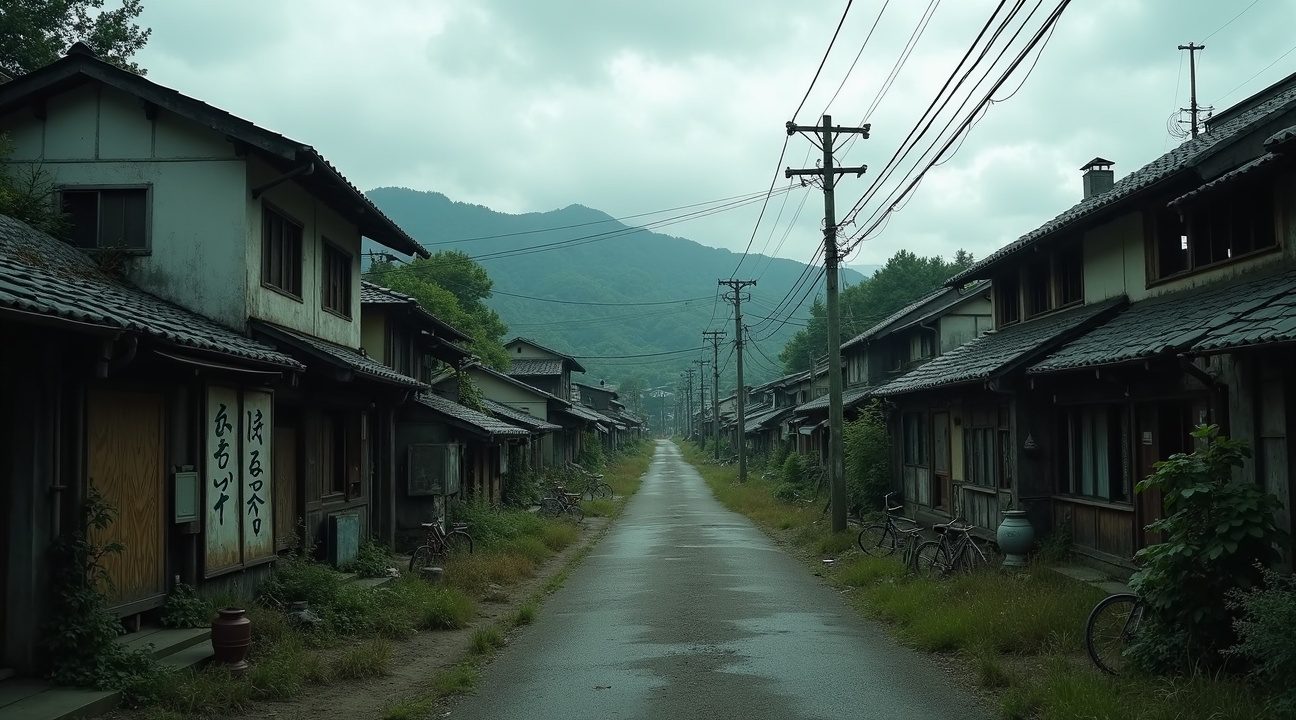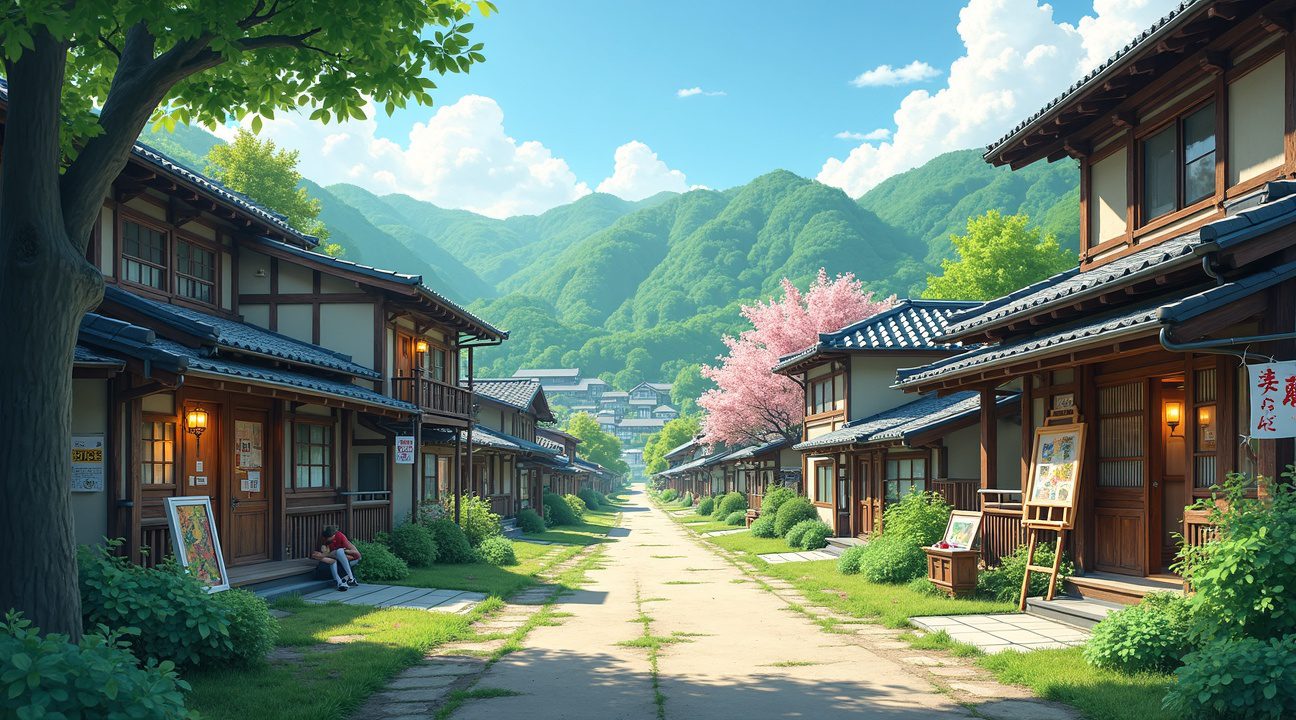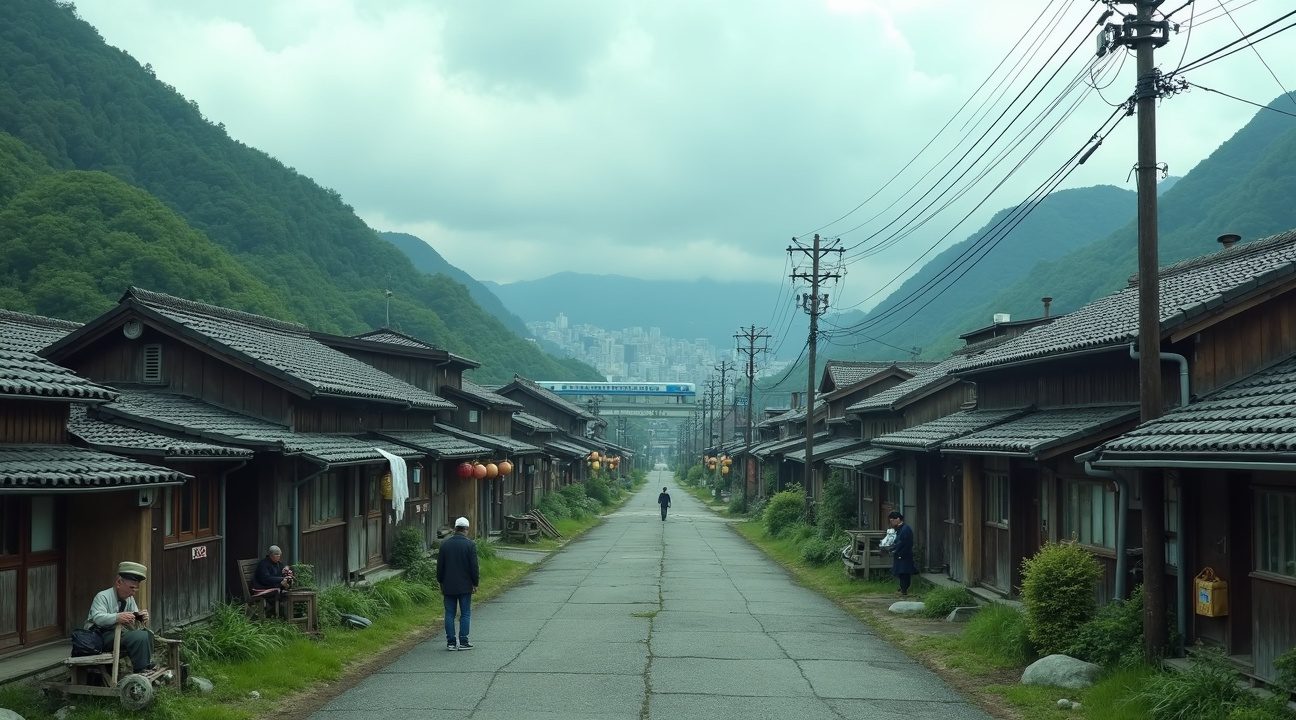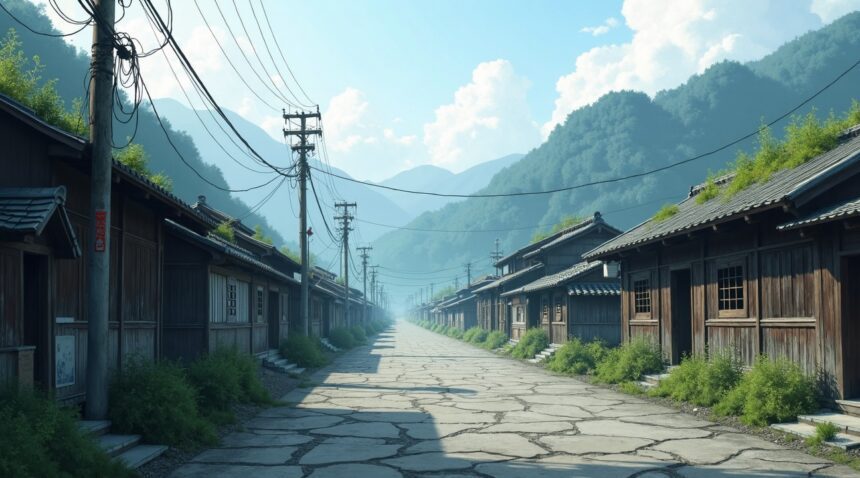Japan’s demographic crisis has created an unprecedented housing situation with 9 million vacant homes as of 2023, representing nearly 14% of the nation’s total housing stock and marking the highest vacancy rate in the country’s recorded history.
This massive oversupply has driven property values so low that some abandoned homes, known as “akiya,” are selling for as little as $500, creating unique opportunities for buyers while reflecting the severe impact of Japan’s aging and declining population on rural communities.
Key Takeaways
- Japan recorded 9 million vacant homes in 2023, doubling from 4.5 million in 1993, with the highest vacancy rates in rural prefectures like Wakayama at 21.2%
- Government-backed sales programs are offering abandoned properties for as little as $500 to shift maintenance responsibilities and stimulate community revitalization
- Japan’s aging population and urban migration continue to drive property abandonment, with vacancy projections reaching 30.4% by 2033
- Inheritance laws and taxation policies discourage property maintenance, making abandonment more favorable than managing legal and financial burdens
- The crisis deepens geographic inequality, as urban centers like Tokyo see property price increases while rural markets deteriorate
Rural Decline and the Oversupply Crisis
The scale of Japan’s vacant home problem defies conventional real estate logic. Rural regions bare the brunt of this crisis, with entire villages now featuring more empty structures than occupied ones. Homes that once hosted vibrant communities now serve as haunting reminders of demographic collapse.
Government Incentives and Sales Strategies
To combat abandonment, local municipalities have launched government initiatives offering akiya at dramatically reduced prices. These homes are often sold with incentives such as renovation subsidies and move-in support. The overarching goal is to transfer costs from financially strained governments to private individuals willing to invest in long-term maintenance.
Inheritance and Legal Complexity
Japan’s inheritance laws often divide properties among multiple heirs, creating complex ownership structures that hinder decision-making. The legal and financial workload encourages families to abandon properties rather than pursue lengthy court processes for transfer or demolition.
Population Shifts and Migration Patterns
Younger generations continue to migrate to urban centers, leaving ancestral homes behind in rural towns. As older residents pass away or move into care facilities, many of these properties are left unoccupied. The depopulation cycle leads to cuts in local services, worsening conditions and further increasing migration rates.
Tax Policies and Demolition Disincentives
Japanese tax structures inadvertently reinforce the vacant home problem. Property taxes remain relatively modest for lots with unoccupied homes, but increase considerably when structures are demolished. This disincentive encourages property owners to preserve old buildings rather than clear space for redevelopment.
Urban-Rural Property Imbalance
The widening gap between rural and urban markets is striking. While Tokyo’s real estate values have surged by over 30%, rural home prices continue to decline. This economic mismatch underscores the uneven population and wealth distribution influencing Japanese society.
Addressing Safety Concerns
Deteriorating structures pose growing risks. Abandoned houses frequently become fire hazards, attract pests, and threaten surrounding buildings. Local governments, limited by small budgets and shrinking workforces, struggle to mitigate these urgent safety concerns.
Foreign Investment Interest
Outside buyers have begun entering Japan’s distressed property market. Some purchase akiya as vacation homes or for rental income. Others view them as long-term investments should market recovery occur. However, foreign nationals must navigate Japanese visa and residency requirements when purchasing.
Renovation Costs vs Purchase Price
Though a home may cost only a few hundred dollars, necessary renovations often exceed tens of thousands. Projects typically require electrical rewiring, plumbing repair, insulation upgrades, and adherence to modern building codes. Prospective buyers should budget realistically for these upgrades.
Mixed Outcomes from Revitalization Campaigns
Community efforts have led to varied results. In some areas, strategic marketing and incentive programs have attracted new residents. Elsewhere, despite generous offers, population decline continues. Local success depends on factors like access to transport, employment, and educational facilities.
Global Relevance and Lessons Learned
The rise of akiya isn’t just a Japanese issue—it offers a cautionary case study for other aging nations. Countries experiencing similar demographic slowdowns can learn from Japan’s policy responses and their varying degrees of success.
Investment Risks in Rural Japan
Investing in rural property comes with uncertainty. While some speculate on eventual market correction, experts predict population decline will continue across many remote regions. Informed investors must carefully assess local economies and demographic trends.
Policy Developments and Future Outlook
Japan’s government continues evaluating policy adjustments, including laws designed to simplify property transfer and boost ownership incentives. Nonetheless, deep structural demographic challenges mean the akiya issue is far from resolved. Long-term policy stability and innovation will be key to addressing this growing concern.
Record-Breaking 9 Million Vacant Homes Transform Japan’s Housing Landscape
Japan faces an unprecedented housing crisis with a staggering 9.0 million vacant homes recorded as of October 1, 2023, marking a dramatic increase from 8.49 million just five years earlier in 2018. This astronomical figure represents approximately 13.8% to 14% of all housing stock nationwide, establishing the highest vacancy proportion in the country’s recorded history.
The scale of this phenomenon becomes clear when considering that these 9 million empty houses actually outnumber the entire population of New York City. The trajectory shows no signs of slowing down, as vacant properties have doubled over the past three decades, rising from 4.5 million in 1993 to today’s record-breaking numbers.
Regional Disparities Reveal Deepest Impact Areas
The vacancy crisis doesn’t affect all regions equally across Japan’s prefectures. Wakayama Prefecture leads with the highest vacancy rate at 21.2%, followed closely by Tokushima Prefecture at an identical 21.2%, and Yamanashi Prefecture at 20.5%. These statistics paint a stark picture of rural depopulation and economic decline in specific areas.
These regional variations highlight how Japan’s demographic challenges create concentrated pockets of abandonment. Rural prefectures face the most severe impacts as younger generations migrate to urban centers for employment opportunities, leaving behind properties that become increasingly difficult to maintain or sell. The phenomenon affects entire communities, creating ghost neighborhoods where Japanese cultural practices of community maintenance struggle against overwhelming economic realities.
The term “akiya”, referring to these abandoned houses, has become increasingly common in Japanese real estate discussions. These properties often fall into disrepair as aging owners pass away or move to care facilities, leaving inheritances that younger family members can’t or won’t maintain. Many properties sit empty for years, accumulating maintenance issues and declining in value until they’re eventually sold for minimal amounts.
Local governments across affected prefectures grapple with the consequences of widespread vacancy. Empty homes create safety hazards, reduce property values for neighboring residents, and strain municipal resources for maintenance and eventual demolition. Some areas have implemented programs to attract new residents or convert vacant properties for alternative uses, but these efforts often struggle against the overwhelming scale of the problem.
The real estate crisis extends beyond simple numbers, reflecting Japan’s broader demographic transformation. As the population ages and birth rates remain low, demand for housing continues to decline while the existing housing stock remains largely intact. This mismatch creates a self-perpetuating cycle where property values decline, making ownership less attractive and abandonment more likely.
Economic factors compound the challenge, as maintaining properties in rural areas becomes increasingly expensive relative to their market value. Many owners find themselves spending more on upkeep, taxes, and utilities than properties could realistically generate through rental income or eventual sale. This economic reality drives many to simply walk away from properties that have become financial burdens rather than assets.
The situation reflects broader patterns of demographic change that affect not just housing but entire community structures. Schools close due to lack of students, businesses shutter from reduced customer bases, and infrastructure becomes harder to maintain with fewer residents contributing to local tax bases.
Some entrepreneurial individuals and organizations have begun exploring creative solutions for Japan’s akiya problem. International buyers sometimes purchase these properties for remarkably low prices, with some homes selling for as little as $500, though buyers typically face significant renovation costs and complex legal requirements for foreign ownership.
The 9 million vacant homes represent more than just empty buildings—they symbolize a fundamental shift in Japanese society. Each abandoned property tells a story of demographic change, economic pressures, and cultural transformation that extends far beyond real estate markets into the very fabric of Japanese communities.

Akiya Houses Selling for as Little as $500 Create Unprecedented Opportunities
I’ve watched Japan’s akiya phenomenon transform from a housing crisis into an unexpected goldmine for creative investors and lifestyle seekers. These abandoned homes, scattered across depopulated rural regions, offer entry points into property ownership that seem almost too good to be true. The most remarkable deals I’ve encountered involve complete houses selling for just $500, creating opportunities that didn’t exist anywhere else in the developed world.
Government-Backed Sales Programs Drive Ultra-Low Pricing
Local governments across Japan have embraced akiya sales as a strategic solution to rural decline. I’ve seen municipalities launch dedicated online platforms that showcase available properties with transparent pricing structures. These government-backed initiatives often feature homes priced between $500 and $10,000, depending on location and condition. Rural prefectures like Okayama and Tottori lead these efforts, recognizing that attracting new residents matters more than maximizing sale prices.
The pricing strategy reflects practical economics rather than charitable gestures. I’ve observed that maintenance costs for empty properties drain municipal budgets while contributing nothing to local tax revenues. When governments sell akiya for nominal amounts, they transfer maintenance responsibilities to motivated buyers while potentially revitalizing entire neighborhoods.
Creative Transformations Fuel Rural Renaissance
Buyers I’ve met have transformed these budget properties into remarkable ventures that benefit local communities. The conversion possibilities include:
- Boutique guesthouses that attract tourists to forgotten villages
- Artist studios and creative retreats in inspiring natural settings
- Remote work offices for digital nomads seeking affordable bases
- Co-living spaces that bring young professionals to aging communities
- Workshop venues for traditional crafts and modern skills training
Government subsidies sweeten these deals considerably. I’ve documented renovation grants reaching up to 50% of improvement costs, plus additional incentives for businesses that create local employment. These programs recognize that successful akiya buyers often become community anchors who attract further investment.
The transformation process requires realistic expectations about renovation challenges. Most $500 akiya need substantial work to meet modern living standards, but I’ve seen buyers accomplish remarkable renovations for total investments under $50,000. Japan’s cultural appreciation for craftsmanship and attention to detail helps ensure these projects maintain high standards despite budget constraints.
Rural revitalization through akiya sales creates ripple effects that extend beyond individual properties. I’ve witnessed villages gain new energy when committed buyers establish businesses, participate in local festivals, and contribute skills that aging populations desperately need.

Aging Society and Population Decline Drive Housing Crisis
Japan’s demographic transformation has created an unprecedented housing crisis that stretches far beyond simple supply and demand economics. I’ve observed how the country’s rapidly aging society has fundamentally altered the landscape of property ownership and community sustainability across rural and suburban areas.
The statistics paint a stark picture of Japan’s demographic challenges. In 2022 alone, Japan experienced a population loss exceeding 800,000 people, with only 770,000 births recorded during that same period. The current birth rate of 1.32 falls significantly below the replacement level needed to maintain a stable population. These numbers reveal the magnitude of change facing Japanese society, as projections indicate the population will shrink from 125 million to approximately 88 million by 2065—a staggering reduction of nearly 30%.
This dramatic population decline directly correlates with the housing abandonment crisis. Young Japanese increasingly gravitate toward urban centers, leaving behind family properties in rural and suburban areas. Many inherited homes sit empty because younger generations have little interest in maintaining or occupying properties outside major metropolitan areas. The cultural shift toward nuclear families has also disrupted traditional patterns of multigenerational home ownership that once kept properties occupied across generations.
Urban Migration Patterns and Property Abandonment
Several interconnected factors drive the abandonment of rural properties across Japan. Urban migration remains the primary catalyst, as younger generations seek employment opportunities and modern amenities available only in cities like Tokyo, Osaka, and Nagoya. This movement creates a cascading effect where rural communities lose their youngest residents, leaving behind an aging population unable to maintain properties or pass them on to willing heirs.
The preference for nuclear families over traditional extended family structures has disrupted centuries-old housing patterns. Previously, multiple generations would occupy family homes, ensuring continuous occupation and maintenance. Today’s families often view inherited rural properties as burdens rather than assets, particularly when these homes require significant repairs or modernization.
Inheritance tax considerations and complex property laws further complicate the situation. Many families find the costs associated with property transfer, maintenance, and taxation exceed any potential benefits of keeping rural homes. The bureaucratic processes involved in property management often deter young urban dwellers from claiming their inheritance rights.
Economic factors also play a crucial role in property abandonment. Rural areas typically offer limited employment opportunities, making it financially impractical for younger generations to maintain homes in these locations. The cost of commuting from rural areas to urban job centers often exceeds any savings from lower rural property costs.
Current projections suggest this crisis will intensify significantly. By 2033, experts estimate that 30.4% of Japan’s homes could stand vacant. This represents more than just empty buildings—these vacant properties signal the collapse of entire communities and the erosion of Japan’s traditional social fabric.
The concentration of earthquake-prone areas in rural regions adds another layer of complexity to the housing crisis. Many aging properties lack modern seismic safety features, creating additional financial burdens for potential occupants or buyers.
Infrastructure challenges compound the problem as rural areas struggle to maintain essential services with shrinking populations. Key consequences include:
- School closures
- Reduced public transportation services
- Limited access to healthcare facilities
These limitations make rural areas even less attractive to younger families, creating a self-reinforcing cycle where population decline leads to reduced services, which in turn accelerates further population loss.
The cultural aspects of this demographic shift reflect broader changes in Japanese society. Traditional values emphasizing connection to ancestral homes and rural communities compete with modern desires for urban convenience and career advancement. Many young Japanese find themselves torn between honoring family traditions and pursuing practical life choices that lead them away from inherited properties.
This housing crisis represents more than an economic challenge—it threatens the preservation of traditional Japanese communities and cultural practices tied to rural life. As homes sit empty and communities shrink, centuries of local traditions, festivals, and social networks face extinction alongside the physical structures that once supported them.

Complex Tax and Legal Barriers Worsen the Empty Home Problem
Japan’s inheritance and property tax structures create perverse incentives that encourage owners to abandon homes rather than maintain or demolish them. Current policies make it financially punishing to tear down deteriorating structures, as vacant land faces significantly higher property taxes than land with buildings. This system traps owners in a cycle where maintaining an empty home seems more economical than taking decisive action.
Inheritance Laws Create Additional Complications
Inheritance procedures add another layer of complexity to Japan’s empty home crisis. Multiple heirs often share ownership of properties, making unanimous decisions about demolition or sale nearly impossible to achieve. Legal battles can drag on for years while properties continue to decay, creating safety hazards and neighborhood blight.
Property law reforms have attempted to address these issues with mixed success. Since 2015, municipalities gained authority to designate dangerous structures as “special vacant houses” and force repairs or demolition. However, enforcement remains inconsistent across different regions, and many local governments lack the resources to actively monitor thousands of empty properties.
Recent Tax Reforms Target Persistent Vacancy
Government initiatives now focus on financial penalties for long-term vacant properties. Recent reforms allow municipalities to impose standard property tax rates on land beneath homes that remain empty for extended periods. These changes aim to eliminate the tax advantage that previously made abandonment attractive.
Demolition costs present another significant barrier, often ranging from $10,000 to $30,000 for typical residential structures. Many elderly property owners simply can’t afford these expenses, especially when they’re already struggling financially. Absentee ownership compounds the problem, as heirs who’ve moved to urban areas often lack emotional or financial motivation to deal with rural properties.
The tax and legal framework continues evolving, but enforcement challenges persist. Local governments must balance property rights with community safety concerns while managing limited budgets. Some municipalities offer demolition subsidies or tax incentives to encourage action, but these programs remain limited in scope. Cultural shifts in Japanese society also influence how families view inherited properties, with younger generations increasingly disconnected from rural ancestral homes.
These structural barriers explain why millions of properties remain vacant despite growing international interest in affordable Japanese real estate. Until comprehensive reform addresses both tax incentives and inheritance procedures, the empty home problem will likely persist across Japan’s aging communities.
Urban Markets Thrive While Rural Properties Collapse
Japan’s property market presents a stark tale of two worlds, where gleaming urban centers attract billions in investment while rural communities watch their real estate values crumble. This dramatic divide reflects the country’s broader demographic shifts and creates both opportunities and challenges for property investors.
Tokyo’s Real Estate Boom Defies National Trends
Tokyo’s property market continues its remarkable upward trajectory, with apartment prices surging 30% over the past five years despite Japan’s shrinking population. Land prices have climbed up to 12% in prime urban areas, creating a striking contrast to the national narrative of empty homes and declining values. Foreign investors recognize this opportunity, pouring $10.2 billion into Japanese real estate during just the first half of 2023.
International buyers particularly favor Tokyo’s commercial and residential properties for several compelling reasons. The city’s infrastructure remains world-class, employment opportunities concentrate in the capital, and the yen’s recent weakness makes Japanese assets more attractive to overseas purchasers. Japan’s earthquake preparedness and building standards also reassure foreign investors about long-term safety.
The capital’s magnetism draws young professionals and families from across Japan, creating sustained demand that counteracts the broader population decline. Urban migration patterns ensure that while rural areas empty out, Tokyo’s property market maintains its vitality through both domestic relocation and international investment.
Rural Areas Face Property Value Collapse
Rural Japan tells a dramatically different story, where declining populations drive property values into freefall. Small towns and villages struggle with an oversupply of homes as residents migrate to cities or pass away without heirs willing to maintain rural properties. The result is a vicious cycle where falling prices discourage maintenance, leading to further deterioration and even lower values.
Provincial areas face unique challenges that urban markets don’t encounter:
- Limited employment opportunities reduce local demand for housing
- Aging infrastructure and declining public services make rural living less attractive
- Transportation links to major cities remain poor or continue deteriorating
- Local governments lack resources to address abandoned properties effectively
- Cultural shifts mean younger generations prefer urban lifestyles over traditional rural living
These factors combine to create markets where properties sell for mere hundreds of dollars, reflecting their minimal economic value in areas with no growth prospects. Unlike urban centers that benefit from Japan’s cultural resurgence, rural regions struggle to attract even domestic interest.
The demographic reality underlying this divide reveals itself in stark numbers. Rural municipalities report population declines of 20-30% over the past two decades, while Tokyo’s metropolitan area continues growing. This concentration effect means urban real estate benefits from scarcity and competition, while rural properties suffer from abundance and abandonment.
Senior housing represents one bright spot in Japan’s changing property landscape, with demand rising for barrier-free apartments and healthcare-accessible facilities. Developers increasingly focus on age-friendly designs that accommodate mobility limitations and provide easy access to medical services. These specialized properties command premium prices in urban areas where older residents want to remain close to family and healthcare infrastructure.
The international investment surge reflects global confidence in Japan’s urban markets despite demographic headwinds. Institutional investors from Asia, North America, and Europe view Tokyo’s property market as stable and undervalued compared to other major global cities. Currency advantages, political stability, and transparent legal systems make Japanese urban real estate particularly attractive to foreign capital.
This two-speed property market likely will persist as demographic trends continue shaping Japan’s economic geography. Urban centers maintain their appeal through employment concentration and infrastructure investment, while rural areas face ongoing challenges from population decline and economic stagnation. Smart investors recognize these patterns and position themselves accordingly, focusing on urban opportunities while avoiding rural property traps.
Safety Hazards and Neighborhood Deterioration From Abandoned Properties
Vacant properties across Japan create significant safety threats that extend far beyond individual structures. These empty homes often become magnets for illegal dumping, transforming once-pristine neighborhoods into areas plagued by accumulated waste and debris. I’ve observed how these properties deteriorate rapidly without proper maintenance, developing structural weaknesses that pose serious risks to nearby residents and passersby.
Fire hazards represent another critical concern with abandoned Japanese homes. Dried vegetation, accumulated debris, and aging electrical systems create perfect conditions for accidental blazes. These fires can spread quickly to neighboring properties, especially in densely populated areas where homes sit close together. Pest infestations also flourish in vacant structures, with rodents and insects establishing colonies that eventually spread to surrounding buildings.
Infrastructure Decline and Community Impact
The presence of multiple empty homes creates a domino effect that accelerates neighborhood decline. Property values drop significantly when abandoned houses dot the landscape, affecting homeowners who maintain their properties but find their investments losing worth. This economic impact creates additional challenges as fewer resources become available for community improvements and local services.
Infrastructure systems suffer as well when large numbers of homes remain vacant:
- Water pipes can freeze and burst in winter, flooding foundations and creating mold problems.
- Unmaintained septic systems and drainage can lead to environmental contamination that affects surrounding properties.
- Roads and utilities serving these areas often receive reduced maintenance priority from local governments.
This further contributes to the cycle of decline.
I notice that entire neighborhoods can transform from thriving communities to areas with reduced social cohesion and safety. The natural disasters that occasionally affect Japan compound these issues, as abandoned structures become more vulnerable to collapse during seismic events.
Criminal activity sometimes increases in areas with high vacancy rates. Empty homes provide hiding spots for illegal activities and can attract transients seeking shelter. The lack of active community members means fewer eyes watching for suspicious behavior, reducing natural neighborhood security.
Local governments face mounting pressure to address these deteriorating conditions, but limited budgets and the sheer scale of the problem create ongoing challenges. Many municipalities struggle to balance enforcement actions with the costs of property remediation, while residents watch their communities decline around numerous vacant structures.
The cumulative effect creates neighborhoods where remaining residents feel increasingly isolated and concerned about their safety. Property maintenance standards often slip as owners lose motivation to invest in areas surrounded by abandoned homes, accelerating the overall deterioration process.
Sources:
Nippon.com: “Number of Vacant Homes in Japan Reaches Record 9 Million”
2OceansVibe: “Japan Now Has Over 9 Million Empty Homes Due To Declining Population”
elpais.com: “Japan struggles to address growing number of empty houses”
Futuristspeaker.com: “The Coming Vacant Home Crisis in an Aging, Low Birth Rate Society”
e-housing.jp: “Tokyo Residential Real Estate Market Analysis 2024: Impact of Low Birth Rate”
Nippon Tradings: “Navigating the Japan 2025 Problem”
Hospitalitynet.org: “How Japan’s Vacant Akiya Houses Are Becoming Hospitality Assets”


